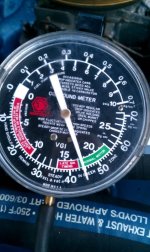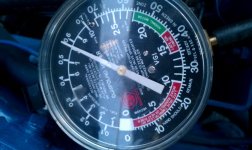Eric.C
Contributing Member
This has been going on for several months now, and I am really starting to bang my head against the wall. My starboard Crusader RH 454 (Model 350, circa 1989-ish?) has been backfiring out the carb under load around 2500 RPM, or just about any RPM if the throttle is blipped quickly in neutral. The engine purrs like a kitten at idle, and runs smooth as silk up to about 2500 RPM's where it will start to backfire and fall flat on it's face.
Here is the run-down of what we have done so far. What am I missing? Any more ideas?
Checked timing... slightly off, but not enough to backfire. Adjusted anyway.
Replaced fuel/water seperator and inline carb filter... no change.
Checked fuel pressure at carb inlet... 6 PSI continuous, even while backfiring.
Swapped carbs from port <---> starboard... problem stayed with starboard.
Swapped ignition coils... problem stayed with starboard.
Swapped complete distributors (cap, rotor, wires... the whole deal)... problem stayed with starboard.
Replaced plugs... no change
Ripped some of my hair out... no change
Jumped coil's ignition wire straight to battery (bad ign wire? Low volt?)... no change.
Compression test results:
Cyl 1 - 150 Cyl 2 - 150
Cyl 3 - 150 Cyl 4 - 148
Cyl 5 - 150 Cyl 6 - 150
Cyl 7 - 148 Cyl 8 - 149
Vacuum at idle is perfectly-steady 17.5 in/hg...
Completely out of ideas... sticking valve? ...
Pulled the heads and took to machine shop. Heads were tanked, magna-fluxed, disassembled and completely inspected. Spring pressures were measured, valve seats were "not perfect, but wouldn't cause a popping" so he did a light grind and lap. Guides and stems looked perfect... (couldn't go wrong for only $100 in labor, $110 in gaskets, and a saturday's work).
While the heads and intake were off, put a dial indicator on the cam and measured every lobe. Lift values from #8 exhaust down to #1 intake:
0.258"
0.266"
0.248"
0.274"
0.255"
0.267"
0.267"
0.277"
0.273"
0.275"
0.275"
0.275"
0.278"
0.274"
0.269"
0.278"
Granted some are a little low/worn, but would that cause a backfire? I wouldn't think so.
Reassembled with lots of lube, started, warmed up, adjusted valve lash while idling (1 turn past lash), installed valve covers, and low and behold...
STILL BACKFIRING!!!!!!!
I am completely out of ideas here. I have ruled out ignition. I have ruled out fuel. I have ruled out a valvetrain problem. Compression is perfect...
Any thoughts on cam timing possibly being off? Chain maybe skipped a tooth? Is this a common problem on these? Any easy way to check without pulling the front cover?
EDIT: This all started happening when we put some "rebuilt" carbs on the boat. One of them was dumping raw fuel like the float was stuck down or something. We were literally spitting raw fuel out the exhaust. When the backfiring started, it would occur at 3k RPM. When we got back, there was literally a gallon of fuel in the oil. I flushed the oil out three times. Next time we took the boat out (old carbs put back on), it was backfiring at 2700 RPM. Next trip was moving the boat from Long Beach to Dana Point, and it was then backfiring at 2500 RPM. Not sure if that is pertinent information or not, but it seems to have gotten worse a couple times, now it is 2500 RPM every trip out.
I work on pretty much nothing but OBDII Hondas, so this Carb'ed BBC stuff is new to me. I would appreciate any help/ideas. Case of beer to the winning suggestion, hehe.
Thanks!!
Eric
Here is the run-down of what we have done so far. What am I missing? Any more ideas?
Checked timing... slightly off, but not enough to backfire. Adjusted anyway.
Replaced fuel/water seperator and inline carb filter... no change.
Checked fuel pressure at carb inlet... 6 PSI continuous, even while backfiring.
Swapped carbs from port <---> starboard... problem stayed with starboard.
Swapped ignition coils... problem stayed with starboard.
Swapped complete distributors (cap, rotor, wires... the whole deal)... problem stayed with starboard.
Replaced plugs... no change
Ripped some of my hair out... no change
Jumped coil's ignition wire straight to battery (bad ign wire? Low volt?)... no change.
Compression test results:
Cyl 1 - 150 Cyl 2 - 150
Cyl 3 - 150 Cyl 4 - 148
Cyl 5 - 150 Cyl 6 - 150
Cyl 7 - 148 Cyl 8 - 149
Vacuum at idle is perfectly-steady 17.5 in/hg...
Completely out of ideas... sticking valve? ...
Pulled the heads and took to machine shop. Heads were tanked, magna-fluxed, disassembled and completely inspected. Spring pressures were measured, valve seats were "not perfect, but wouldn't cause a popping" so he did a light grind and lap. Guides and stems looked perfect... (couldn't go wrong for only $100 in labor, $110 in gaskets, and a saturday's work).
While the heads and intake were off, put a dial indicator on the cam and measured every lobe. Lift values from #8 exhaust down to #1 intake:
0.258"
0.266"
0.248"
0.274"
0.255"
0.267"
0.267"
0.277"
0.273"
0.275"
0.275"
0.275"
0.278"
0.274"
0.269"
0.278"
Granted some are a little low/worn, but would that cause a backfire? I wouldn't think so.
Reassembled with lots of lube, started, warmed up, adjusted valve lash while idling (1 turn past lash), installed valve covers, and low and behold...
STILL BACKFIRING!!!!!!!
I am completely out of ideas here. I have ruled out ignition. I have ruled out fuel. I have ruled out a valvetrain problem. Compression is perfect...
Any thoughts on cam timing possibly being off? Chain maybe skipped a tooth? Is this a common problem on these? Any easy way to check without pulling the front cover?
EDIT: This all started happening when we put some "rebuilt" carbs on the boat. One of them was dumping raw fuel like the float was stuck down or something. We were literally spitting raw fuel out the exhaust. When the backfiring started, it would occur at 3k RPM. When we got back, there was literally a gallon of fuel in the oil. I flushed the oil out three times. Next time we took the boat out (old carbs put back on), it was backfiring at 2700 RPM. Next trip was moving the boat from Long Beach to Dana Point, and it was then backfiring at 2500 RPM. Not sure if that is pertinent information or not, but it seems to have gotten worse a couple times, now it is 2500 RPM every trip out.
I work on pretty much nothing but OBDII Hondas, so this Carb'ed BBC stuff is new to me. I would appreciate any help/ideas. Case of beer to the winning suggestion, hehe.
Thanks!!
Eric
Last edited:



